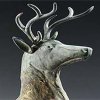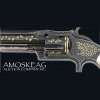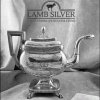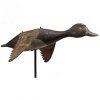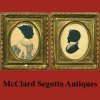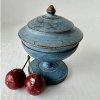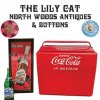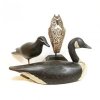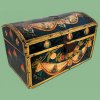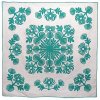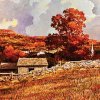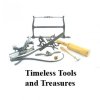The Winter Antiques Show 2017
January 19th, 2017
New York City
The Winter Antiques Show, the grande dame of antiques shows, now in its 63rd year, was bedecked with giant digital snowflakes high on the walls and with real flowers on the floors and chandeliers. The show is like a dowager—elegant and traditional. The energy of her youth, when Americana collectors would rush in to their favorite stands at the 5 p.m. preview, is a memory of a decade or two ago. This year the smaller crowd was more deliberate and less impatient than in the old days. They seemed cautious and bought thoughtfully. Dealers said buyers were more willing to open their wallets this year than in the recent past and that the market had reached its bottom and was on the uptick.
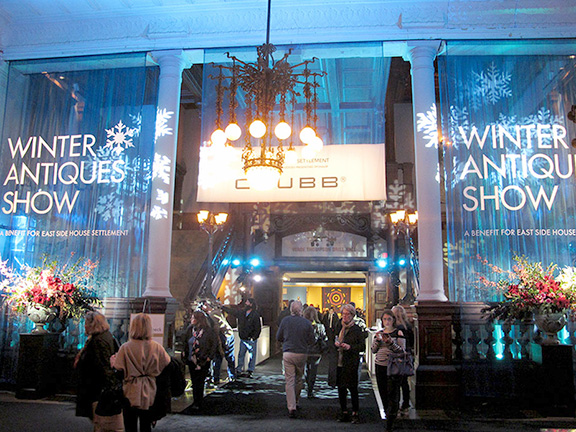
Sally Apfelbaum photo.
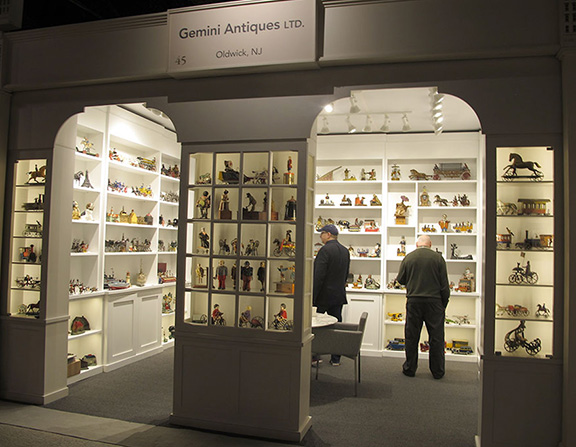
The Gemini Antiques booth was the busiest at the fair. Sally Apfelbaum photo.
Because M.A.D. is the “The Marketplace for Americana,” this review will cover only Americana at the show. Even though each year it has less of a presence, Americana is, nonetheless, the focus for a passionate group of collectors and curators. The loan show celebrates Americana Week, while auctions continue to attract a significant audience for Americana.
Some Americana dealers sold well, others did just OK, and all of them said they will keep on selling long after the show closes. American paintings were a strong suit. New York City dealer Michael Altman sold two paintings by William J. McCloskey and one each by John Singer Sargent, Martin Johnson Heade, and Maxim Gorky. Philadelphia dealer Robert Schwarz sold paintings by George Cochran Lambdin, Hermann Herzog, Adolphe Borie, and William Hart and a pair of portraits by Samuel F.B. Morse. Both dealers had interest in other works. The four other American painting dealers and two dealers in American prints reported good sales as well.
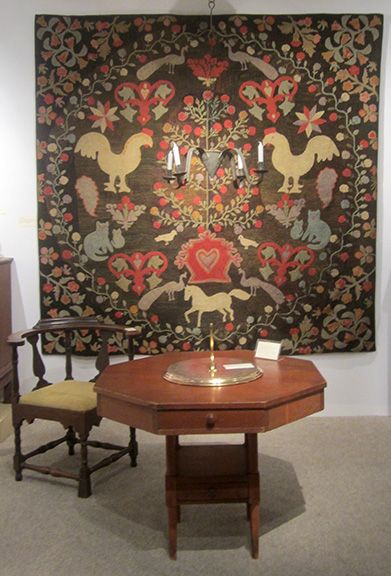
Elliott and Grace Snyder of South Egremont, Massachusetts, offered this folk art masterpiece hooked rug, unusually large at 95" x 96", for $65,000. There are pairs of roosters, peacocks, small birds, and blue cats, and there is a white horse under a red vase decorated with a heart from which grows a flowering tree. The sundial on the table, signed “T. Heath, London,” has a coat of arms and was made for Hampton Court. It sold. Thomas Heath (1698-1773) was a leading London instrument maker at the sign of the Hercules and Globe in the Strand during the reigns of George I and George II, the last of the kings to reside at Hampton Court. The dial is marked with the leading trading posts in England, 1720-53. The Shaker worktable from Enfield, New Hampshire, has four drawers. It was $55,000. The corner chair and the iron chandelier with heart-shaped drip pans sold.

The Bradlee-Fulton family mahogany tea table with slides, Boston, circa 1750, 27" x 29" x 19", was $425,000 from Bernard and S. Dean Levy, New York City, and it sold. Sarah Bradlee Fulton owned the table originally. She is known as the “Mother of the Boston Tea Party.” It is said that she helped some men, including her husband and brother, at her house as they dressed as Native Americans before the Boston Tea Party. She was a leader for the Daughters of Liberty. It is also reported that she carried a message through enemy lines to George Washington. The table was shown at the Museum of Fine Arts, Boston in the exhibition Paul Revere’s Boston in 1975 and in Wendy Cooper’s In Praise of America at the National Gallery of Art in 1980.
The Abby Aldrich Rockefeller Folk Art Museum celebrated its 60th anniversary with a glorious loan exhibition that challenged the folk art dealers to meet the museum’s high standard. The folk portraits for sale at the show were far better than those sold at the week’s auctions; some sold, and some were still available after the show closed.
The elephant in the room, pun intended, was the election of Donald Trump. There was a smaller crowd than usual at the January 19 preview, the night before Trump’s inauguration. A few old-time collectors made a quick run through this show before heading to Washington for the inauguration. Others had left for Washington and went to the show later in the week. Protests in New York City on both weekends of the show did not help attendance, nor did the fact that the long auctions took time and money away from the show. Moreover, the New York Times gave four times the space to the Outsider Art Fair, including the cover story, which in the past has gone to the Winter Antiques Show.
Nevertheless, folk portraits and formal American furniture from the 18th and 19th centuries sold, and some of it was bought by young collectors, according to Frank Levy of Bernard and S. Dean Levy and Elizabeth Feld of Hirschl & Adler, even though these buyers were not the group that the powers that be targeted with a video on social media released on the eve of the show proclaiming that the show was “not your grandmother’s brown furniture,” to the disgust of those who sell it. Very little painted or country furniture was embraced. Americana dealers say the show has been diminished by the inclusion of more 20th-century material as well as 21st-century material that can be ordered new. They say it might bring in the decorators, but it does not bring in a young crowd. On the other hand, Stephen Score of Boston, showing for the first time, said, “The things that excite me about American folk art are the gestural qualities that you find in contemporary art. I like the fact that some twentieth-century things are at the Winter show. It enables viewers to see folk art the way the American painters of the 1920s first discovered it. I like to see American folk art shown near things that challenge what we are seeing so we can see old things in a new way.”
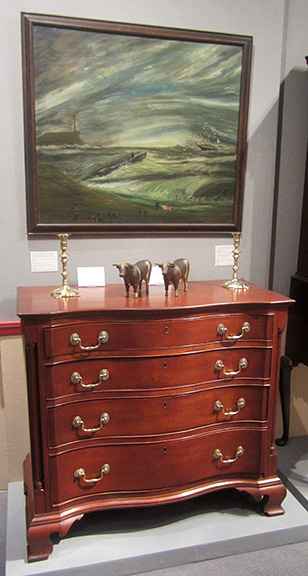
This cherry serpentine chest of drawers with freestanding fluted columns, New London, Connecticut, 1775-80, white pine secondary wood, 34" high x 37" wide (including top) x 19" deep, was $60,000 from Nathan Liverant & Son, Colchester, Connecticut. It sold. The pair of carved Ayrshire oxen with leather tails, probably New England, 1875-1900, 9¼" x 5½", was $5740. The marine landscape of a ship in a storm and survivors on the beach, 1860-85, oil on canvas, 29 1/8" x 33 3/8" including frame, was $25,000.
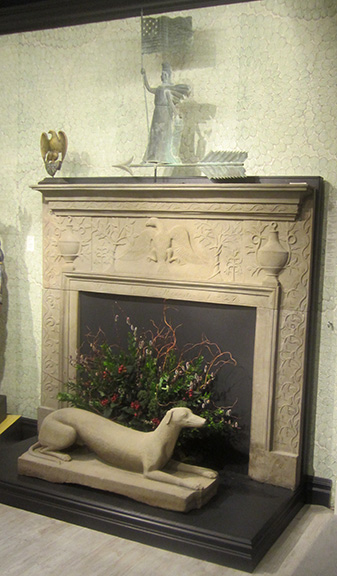
Kelly Kinzle of New Oxford, Pennsylvania, asked $68,000 for the sandstone mantel that came from the Cochran homestead at Oak Dale Farm, Cadiz, Ohio. It is signed and dated 1827 by the stone carver William V.S. Roberts (1789-1859) of Short Creek Township, Harrison County, Ohio. It is 64" high x 74" wide. The carved figure of the greyhound, Portsmouth, Ohio, 1840-60, 19" high x 45½" long x 16" wide, descended in the Farmer family of Portsmouth, Ohio. It is believed to have been carved by an ancestor who arrived there from Virginia in the mid-19th century; it was $40,000. The Lady Liberty weathervane, attributed to a New York maker, circa 1880, copper and zinc with traces of gilding and paint, 39" tall, was $145,000.
Dealers and collectors cite the brilliance of TEFAF (The European Fine Art Fair), which arrived in the U.S. last fall to rave reviews, for scheduling two shows, one for antiques and antiquities in late October, and another for modern design and tribal art in May. TEFAF also made the cultural programs produced at the Park Avenue Armory, along with Memorial Sloan Kettering Cancer Center, the beneficiaries of the opening night reception, assuring its place on the armory’s calendar.
 To be fair, the Winter Antiques Show is the last charity show to survive in New York City. All the proceeds from the preview party and the ten-day gate benefit East Side House Settlement, which has celebrated 125 years of community, educational training, and assistance to people in the South Bronx.
To be fair, the Winter Antiques Show is the last charity show to survive in New York City. All the proceeds from the preview party and the ten-day gate benefit East Side House Settlement, which has celebrated 125 years of community, educational training, and assistance to people in the South Bronx.
“It is unfair to compare the Winter show with TEFAF; they are very different,” said Liz Feld of Hirschl &Adler. “We do a gallery exhibition with pedestals at the fall TEFAF and a homey interior at the Winter show. The Winter show is still the leading market for Americana for those who live with it and for museum curators. Our customers are all ages and from all parts of the country, and we keep in touch with them all year. We tell them what we have, and they come to New York to see it. The Winter Antiques Show is where Americana dealers show the best they have saved for the show all year long. Only two of us are New Yorkers; the rest come from the middle of nowhere, and they meet their clients and curators in New York.”
There is no question that the Winter show is a crossroads, and collectors and curators from all parts of the country check it out. Kelly Kinzle of New Oxford, Pennsylvania, said that late on the last Sunday afternoon of the show a curator asked for pictures, history, and the price of something on his stand. Others said they made sales to museums or to collectors who will give what they bought to a museum. Moreover, all the dealers said that the Winter show is just the beginning of sales and that people who have seen things continue to negotiate purchases in the months that follow. The prices, which seem high, are generally asking prices. Dealers said they are high in order to factor in negotiations, not only museum discounts, but the fact that everyone wants a deal, 10%, or sometimes 20% or 30% off.
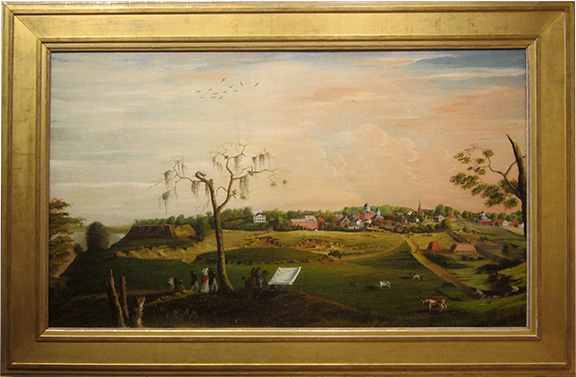
John James Audubon painted View of Natchez in 1823 while he was in Natchez to paint birds for his Birds of America project. The 29 3/8" x 48 3/8" oil on canvas has been well documented and is the only landscape painting by the naturalist. It is historically significant as a document of life along the Mississippi. Adelson Galleries, New York City, asked $5 million for it. Audubon spent a total of 19 months in Natchez, and while there he painted over 30 birds for his Birds of America project. Audubon was commissioned by a Mrs. Griffith of Natchez to paint the scene, but she died before the painting was completed. The view is from a bluff overlooking the Mississippi River, and in the center are two figures painting, possibly depicting Audubon and his son Victor. The painting has a surprising history. It has been owned by several families in Natchez. When Audubon left for New Orleans, he left the painting with Henry and Samuel Postlethwaite, brothers who ran a general store. They finally sold it in 1825 to the French silversmith Louis Emile Gustave Profilet (1801-1868), who took it to France to show his relatives where he lived. The painting remained in France until 1855 when Profilet returned to Natchez. His son sold the painting to George Malin Davis of Natchez, and it descended in that family until the present day. Adelson Galleries photo.
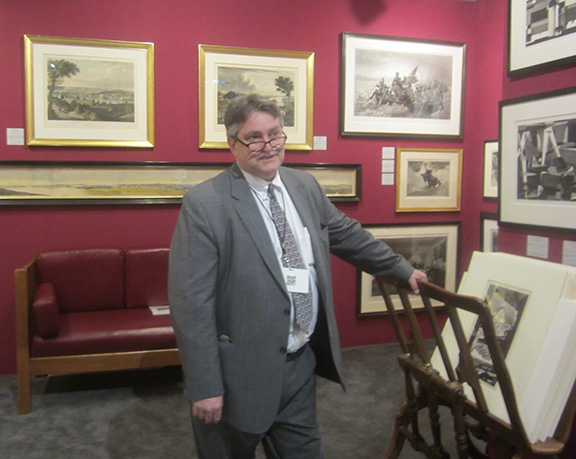
Harry S. Newman of The Old Print Shop, New York City, sold a panoramic view of Boston harbor and part of Charlestown with Bunker Hill done by George Heriot (1759-1839) on June 15, 1815. It was priced at $75,000. It is 7 3/8" x 114½". Heriot was the deputy postmaster general of British North America and the author of The History of Canada from Its First Discovery (1804) and Travels through the Canadas (1807).
Collectors and dealers complain about the shortage of masterpieces and the competition of auctions. Nevertheless, the Winter show is always a treasure hunt full of surprises. For example, this year there were some rare early topographical views of Georgetown and Washington, D.C.; Natchez, Mississippi; and Boston, Massachusetts, seen from Bunker Hill.
This is not a show where booth design is enormously inventive. Some booths look the same every year, but a few stands, all London dealers, showed up the Americans. Cohen & Cohen, dealers in China trade porcelain, demonstrated how to artfully display porcelain without glass cabinets. Didier created a Giorgio de Chirico-inspired setting for jewelry designed by painters, sculptors, and architects, and Apter-Fredericks showed English furniture in a modern library setting with painted books on backlit glass panels. All should have won prizes for booth design, if there were prizes.
Among the dealers in American material, Hirschl & Adler is the perennial winner. This year the gallery’s booth was a dining room with an architectural mantelpiece and a large dining table from the Seymour shop in Boston, and it was crammed with glass decanters, Tucker porcelain, Bennington animals, and wine coasters. Frank Levy employed Ralph Harvard to design his stand, and he sold eight pieces of furniture.
The pictures and captions show only Americana for M.A.D.’s focused audience and just a fraction of what was there from January 19 to 29.
Go to (www.winterantiquesshow.com) for more about the show.
Originally published in the April 2017 issue of Maine Antique Digest. © 2017 Maine Antique Digest





